Every growth-stage product team hits the same roadblocks: Why are users dropping off? Where’s the friction in onboarding? Will this new feature actually land? The fastest way to get answers—and ship better experiences—is by using the right UX research tools: platforms that help you collect direct user feedback, observe behavior, and validate design decisions through surveys, usability tests, heatmaps, and more. We built this guide for teams who are:
- Validating MVPs or new features
- Pinpointing why users churn or abandon
- Streamlining onboarding and product flows
- Collecting continuous feedback to guide roadmap decisions
At Qualaroo, we’ve tested these tools ourselves across surveys, heatmaps, interviews, prototype tests, and more. This isn’t theory. It’s a practical playbook. Now let’s explore different UX survey tools that can help you develop an amazing user experience.
Short on time? I’ve added a comparison table below to make it easier for you to skim and choose your pick.
| Tool | User Rating (G2 & Capterra) |
Free Plan | Core Strength | Starting Price | Key Integrations |
|---|---|---|---|---|---|
| Qualaroo | 4.8 (Capterra) | Yes | Targeted in-product surveys & sentiment AI | $19.99/month. Forever-free plan available with all premium features | Intercom, HubSpot, Slack, Figma (via API) |
| ProProfs Survey Maker | 4.8 (Capterra) | Yes | Surveys + quizzes for UX & onboarding | $19.99/month. Forever-free plan available with all premium features | Salesforce, Mailchimp, MS Teams |
| Maze | 4.5 (G2) | Yes (1 active study per month.) | Prototype testing & concept validation | $99/month | Figma, Adobe XD |
| Userlytics | 4.4 (G2) | No | Global panel + PIP usability sessions | $34/month | Slack, Zoom, MS Teams |
| Lookback | 4.3 (G2) | No | Live interviews + screen recording | $25/month | Google Calendar, Notion (via embed) |
| Dscout | 4.5 (G2) | No | Diary studies, video surveys, live testing | 3000 | Slack, Figma (via link), Zoom |
| User Interviews | 4.6 (G2) | No | Participant recruitment & CRM | $36/session | Zoom, Google Calendar |
| Ethnio | 4.2 (G2) | Free Trial of 14 days | Automated screeners + incentives mgmt | $12/month | Slack, Segment, Zoom |
| Optimal Workshop | 4.4 (Capterra) | No | Info architecture testing (tree, card sort) | $107/user/month | Figma, Jira, Google Analytics |
| Lyssna (Formerly UsabilityHub) | 4.5 (G2) | Yes (Limited to 2-min length for tests and surveys) | Quick tests (first click, preference) | $75/month | Figma, Slack |
| UserTesting | 4.5 (G2) | No | Scalable video-first UX testing | Contact for quote | Salesforce, Segment, GA |
| Mixpanel | 4.6 (G2) | Yes (Limited up to 5 saved reports) | Product & funnel analytics | Contact for quote | HubSpot, Amplitude, Google BigQuery |
| Told | 4.9 (Capterra) | Yes (Limited to 1 seat and 1 survey) | Persona builder + journey map + surveys | Contact for quote | Figma (manual), Slack |
| UXtweak | 4.7 (G2) | Yes (Limited to 1 User license) | All-in-one UX suite + 155M+ user panel | €92/month | Figma, Slack, Google Tag Manager |
| Loop11 | 3.6 (G2) | No | Unmoderated usability & A/B testing | $199/month or $179/month (billed annually) |
Google Tag Manager, Jira |
16 Essential UX Research Tools to Improve User Experience
Here’s the UX research tools list you can implement in your business. Each category groups tools by their core strength and primary use case, helping you instantly identify the right fit for your current UX challenges.
In-Product Surveys & Contextual Feedback
This category is for product teams that want to stop guessing and start optimizing—right from inside the product. Here are the top tools for in-product and contextual surveys:
1. Qualaroo
Let’s start with one of the best survey-based UX research tools. But what makes Qualaroo unique from other UX survey tools is its ability to run prototype testing. If you’re building a product and trying to figure out why users drop off or hesitate at key moments, Qualaroo is the kind of tool that pays for itself fast. We’ve used it in onboarding flows, post-purchase screens, and even prototypes to surface what users won’t tell you in a Zoom call. It’s built for smart, in-context feedback—without interrupting the user experience.
Best For: Product teams who want targeted UX insights from live users without guesswork. Great for validating design, catching friction early, and measuring satisfaction in the moment.
Features
- Create multiple survey types like Exit-intent, CSAT, NPS, SUS, five-second test, and others.
- Add surveys to different web pages or product menus to collect user experience data.
- Embed the survey Nudge™ into the design prototypes to gather feedback about product UI and design.
- Use 12+ question types, automatic language translations, skip-logic, template library, customization options, and survey branding to design targeted surveys.
- Advanced targeting options to collect feedback from the desired audience.
- Built-in AI-based sentiment analysis and word cloud engines to provide real-time feedback analysis.
- A detailed reporting section to create custom reports using filters.
- Integration with several tools like Figma, Salesforce, Intercom, and Slack.
What You Will Like:
- You don’t need a dev sprint to set this up—targeting and logic are marketer-friendly.
- Sentiment AI gives you real insights, not just raw text dumps.
- It scales with you and works for MVPs and mature products alike.
Pricing: Starts at $19.99/month. A forever-free plan is also available (includes access to all premium features).
Average User Ratings (Capterra): 4.8
Customer Review (G2): “Loved the usability. Being able to get feedback from customers while they’re actually on our site is a huge win. No more hoping they’ll respond to an email later.” – Verified User in Marketing and Advertising
Don’t believe our word on it? Watch this case study from UOL Edtech:
2. ProProfs Survey Maker
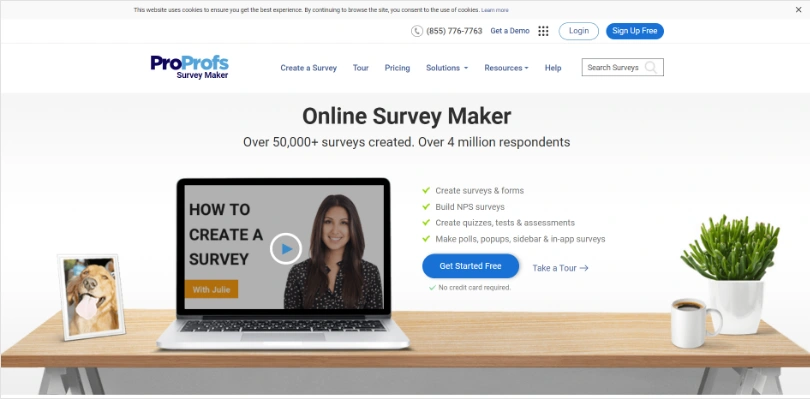
If you need more than surveys to conduct user research, ProProfs Survey Maker is your tool. We’ve used it in multiple UX research projects when we needed a flexible survey tool that just works. It’s another user experience survey tool that uses surveys, quizzes, feedback forms, and polls to gauge user experience. The platform has one of the best reporting sections among feedback tools. You can create presentation-ready reports in real-time and reduce manual data analysis.
Best For: Teams running ongoing UX research through embedded surveys, feedback sidebars, or onboarding questionnaires, without needing technical support.
Features
- Provides a drag-&-drop survey builder to create interactive surveys, polls, assessments, questionnaires, and quizzes.
- Offers 100K ready-to-use survey questions, scoring mechanism, 100+ templates, skip-logic, 15+ question types, and other useful features.
- Uses AI logic branching to dynamically adjust questions based on prior answers, improving data quality and UX relevance.
- Add the survey to your website or mobile app to gauge user experience.
- Provides a feedback sidebar to encourage unsolicited feedback from actual visitors and users.
- Use the built-in detailed reporting section to consolidate and analyze the feedback data.
- Integrate with tools like Salesforce, Mailchimp, MS Teams, and Zapier for CRM.
What You Will Like:
- Simple setup that supports fast iteration—ideal when you need insights mid-sprint.
- Built-in UX-focused templates and logic keep your research structured.
- Sidebar feedback can be deployed without dev support.
Pricing: Paid plan starts at $19.99/month. Includes a forever-free plan with access to premium tools.
Average User Ratings (Capterra): 4.8
Customer Review (Capterra): “ProProfs survey maker has been incredibly helpful for our online store to gather customers’ intent and feedback. The tool is easy to use and creates surveys in minutes. The best part is the unlimited survey creation with the free plan, although we have subscribed to a premium pack later for more advanced features.” – Verified Reviewer in Marketing & Advertising
3. Told
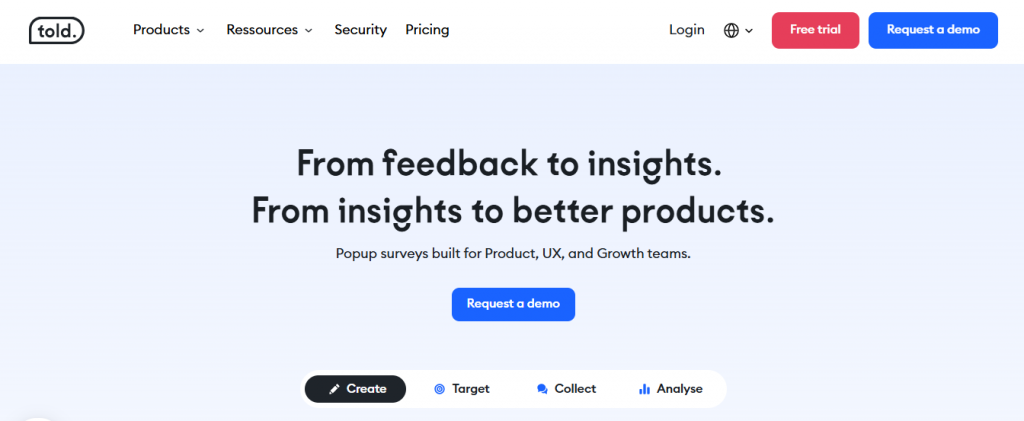
UX research doesn’t stop at feedback collection—it’s about translating that insight into user-centered design decisions. I stumbled across Told while searching for a way to connect post-survey data to design decisions. It is built for that translation. From post-survey analysis to persona creation and journey mapping, it’s one of the few tools that connects the dots between what users say and what your product does next.
Best For: UX teams looking to bridge the gap between user input and UX strategy—especially when stakeholder alignment is key.
Features:
- Conduct targeted UX surveys with logic paths to explore expectations, friction, and perceptions.
- Build detailed user personas from survey data to inform product or design decisions.
- Create journey maps based on user insights to visualize common paths, blockers, and emotional highs/lows.
- Suggestion board allows ongoing collection of UX pain points or feature feedback.
- Ideal for synthesizing qualitative research findings into presentation-ready visuals.
- Integrate with Slack and supports manual export to Figma, making it easy to bring findings into design workflows.
What You Will Like:
- One of the few tools that auto-suggests persona elements and emotional tags from survey data using NLP-based insights.
- Helps align teams around what users actually want, not just what they think they want.
- A great companion to usability testing platforms for downstream synthesis.
Pricing: Contact for quote. Custom plans based on feature needs and team size.
Average User Ratings (Capterra): 4.9
Customer Review (G2): “You can start for free is really easy to used and is available in different languages. For now everything is ok but it doesn’t let me personalize with desig my suvery maybe its because im using the free trial.” – Lissette P., Marketing Coordinator
Usability Testing & Prototype Validation
This category includes tools that help you test prototypes, run unmoderated tasks, validate navigation flows, and benchmark usability before you write production code. Here are the top usability testing & prototype validation tools:
4. Maze

Maze became a go-to for us when we needed to validate designs before investing in usability sessions. It provides a complete toolkit for product managers, content creators, and user experience designers. You can test your products and prototypes, validate content ideas, test website copy, and collect feedback to gauge user satisfaction. It lets you conduct successful tests in hours and make data-backed decisions for continuous development.
Best For: Product teams and designers who need early validation on prototypes, navigation, or messaging—without scheduling live interviews.
Features:
- Build different remote usability tests, such as a tree test, a 5-second test, card sorting, an open question, and more.
- Test product concept, prototype, and content copy to run continuous optimization.
- Add the test studies to your prototype templates to run unmoderated remote testing and map users’ journeys.
- Share the survey and usability test via a link to your participants and maximize reach.
- Use the built-in filters to segment your participant pool.
- Measure test results with quantitative and qualitative data from the reporting dashboard.
- View misclicks, heatmaps, success/failure rates, bounce rates, and other metrics.
- Integrate with Figma, Adobe XD, Slack, and Jira for cross-functional research visibility.
What You Will Like
- AI summarization features identify patterns in task failures and click paths.
- Heatmaps and user path data make usability issues impossible to ignore.
- Perfect balance of speed and depth for fast-moving teams.
Pricing: Paid plan starts at $99/month.
Average User Ratings (G2): 4.5
Customer Review (G2): “I have been using Maze for the last 2 years, and I can say Maze is very helpful in getting very useful insights for our product. There are a few technical limitations, like screen size restrictions, where you cannot use non-responsive products with testers. There is a size limit for the window. Also, sometimes the testing panel members are not up to the mark of expectation.” – Rupesh P., Lead Product Designer
5. UXtweak
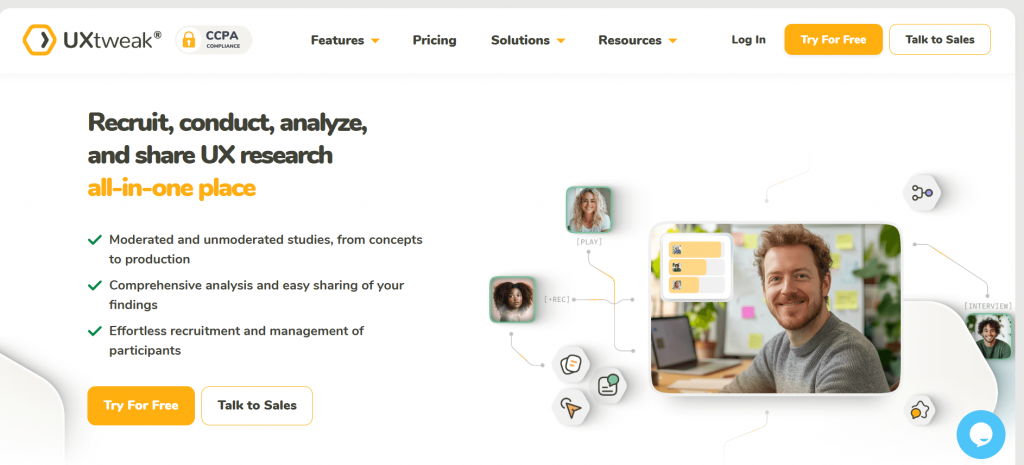
UXtweak is a robust, all-in-one user research platform with powerful tools for usability testing at every stage—from concept to production. UXtweak came onto our radar when we were looking to consolidate tools. You can test your websites, prototypes, and mobile applications both on Android and iOS. You can run any study in either moderated or unmoderated mode—whichever suits your needs best.
Best For: Teams who want an end-to-end UX research platform: from recruiting participants to usability testing to analyzing insights—all without cobbling together multiple tools.
Features:
- All-in-one usability testing platform
- Own Database: A CRM-like tool for managing participants and sending invites for studies.
- Global User Panel with 2000+ profiling attributes for accurate participant recruitment.
- Onsite Recruiting Widget to turn your website visitors into testers.
- Built-in reporting dashboards, detailed analytics, and easy-to-read charts for actionable insights.
- With the UXtweak Custom Plan, you can request onboarding or training sessions for your team.
- Integrate with Figma, Google Tag Manager, and Slack for prototype testing, behavior tagging, and cross-team collaboration.
- Surface usability patterns across tests using automated data clustering.
What You Will Like
- One of the few platforms where you can go from concept → test → report without switching tools.
- Massive user panel saves time on recruitment and segmentation.
- Great onboarding and customer support if you’re setting up complex studies.
Pricing: Starts at €92/month (Basic plan, billed annually). Free starter plan available with access to all core tools.
Average User Ratings (G2): 4.7
Customer Review (G2) “I like how you have all the user research tools in one place. It was a big benefit for us, as the team was not ready to invest in a bunch of different tools every time we introduce a new research method. I really missed branding customization options, it is not available in the Plus plan.” – Jay J., Outreach Specialist
6. Loop11
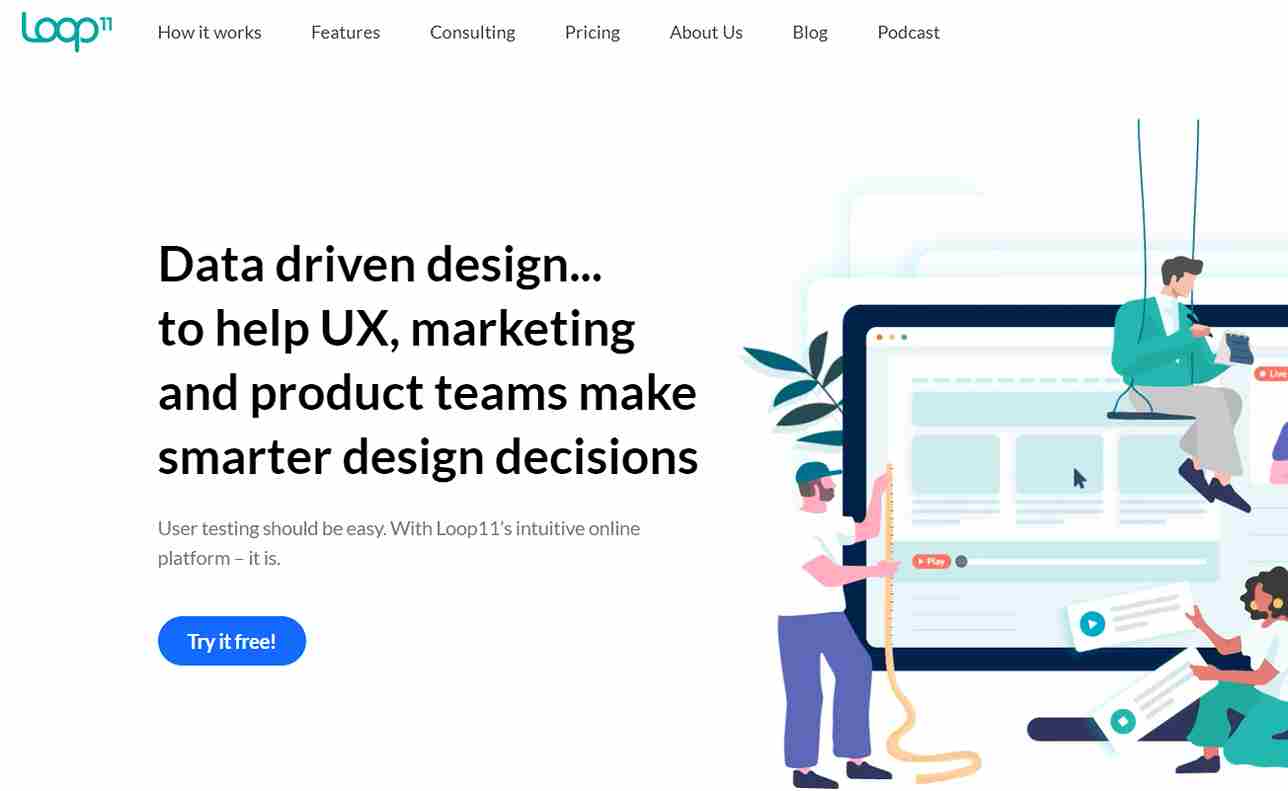
Loop11 is one of the most popular usability testing and UX research tools to validate your concepts and improve products. It was mentioned in a UX forum as a solid choice for task-based testing without getting locked into a heavyweight research suite. The platform comes with advanced features to test your prototype, product information architecture, and benchmarking. You can do all this in both moderated and unmoderated testing environments. It also offers a participant panel to help you find testers easily and produce results in hours.
Best For: UX teams that need to validate navigation, prototypes, or flows through unmoderated usability testing on desktop, mobile, or both.
Features:
- Use the intuitive usability test builder to design your studies without any coding.
- Create multiple tasks like tree test, five-second, first click, and others.
- You can also design and add surveys to collect in-depth feedback from participants.
- Suitable for running tests on any device like mobile, desktop, and tablet.
- Provides video, audio, and screen recording features to gather real-time data from users.
- Edit the video feedback with timestamps, tags, and annotations to create highlight reels.
- Monitor test metrics like time on task, lostness, NPS scores, and task completion rate.
- Use built-in heatmap and clickstream to map the user’s journey during the test.
- Integrate with Google Tag Manager and Jira for event-based triggers and reporting visibility.
What You Will Like:
- Fast setup, no dev time needed—you can launch a study in minutes.
- Video annotation tools make it easy to pull out highlights and pain points.
- AI-assisted session tagging and error flagging help pinpoint user drop-offs without manually reviewing all videos.
Pricing: Starts at $179/month, billed annually
Average User Ratings (G2): 3.6
Customer Review (G2): “I find Loop11 to be quite hectic due to its cumbersome range of features making it a poor tool for testing purposes. The platform has been not satisfactory. Its difficult to pinpoint any shortcomings. I do wish there were tools available especially for automated testing. I have encountered instances of lag.” – Anno C., Employee Assistance Plan Manager
7. Lyssna (formerly UsabilityHub)
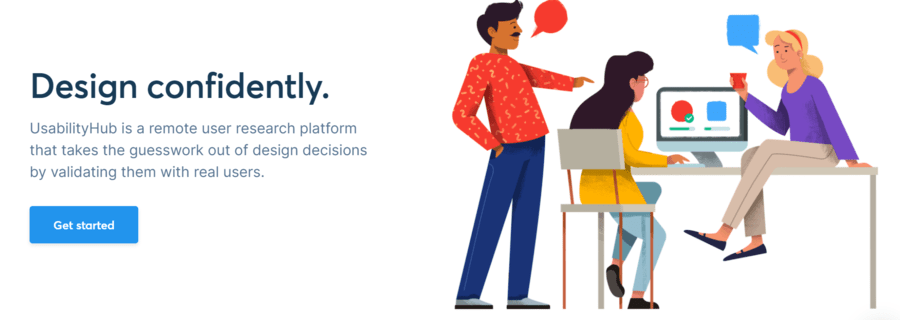
I came across Lyssna back when we were running rapid design sprints and needed validation on everything from button placement to copy tone. It is another user testing software that helps you make data-backed decisions to validate your ideas and improve the product experience for users. You can create a usability test in minutes, add it to the design template, and send it to the desired participants to collect valuable feedback. The tool also supports an easily accessible participant panel to let you find the right people for your tests.
Best For: Designers and UX teams who want to test interface elements, layout preferences, or first-click behavior—especially during prototyping and iteration phases.
Features:
- Run multiple tests like five-second, preference, prototype testing, tree test, and first click.
- Create surveys and embed them into your design templates to collect target feedback from users.
- Supports multimedia question types in surveys like image, video, and audio.
- Offers a dedicated participant panel of over 340K testers.
- Provides integrated heatmaps and clickstream data in your test results.
- Study the test feedback with an inbuilt word cloud generator to pick common themes among the test responses.
- Offers seamless integration with other tools like Figma to collaborate better.
What You Will Like
- AI-generated word clouds and response clusters help distill survey and preference test feedback quickly.
- Combines multiple test types into one platform—ideal for lean teams.
- Helps de-risk early design decisions before investing in build cycles.
Pricing: Starts from $75 per month, billed annually
Average User Ratings (G2): 4.5
Customer Review (G2): “Testing full prototypes with Figma to analyse more detailed behaviour is fantastic on Lyssna. It’s a little time-consuming to set up a block of tests with multiple flows, outcomes, etc. However the “clone” tool goes some way to addressing this.” – Verified User in Market Research
8. UserTesting
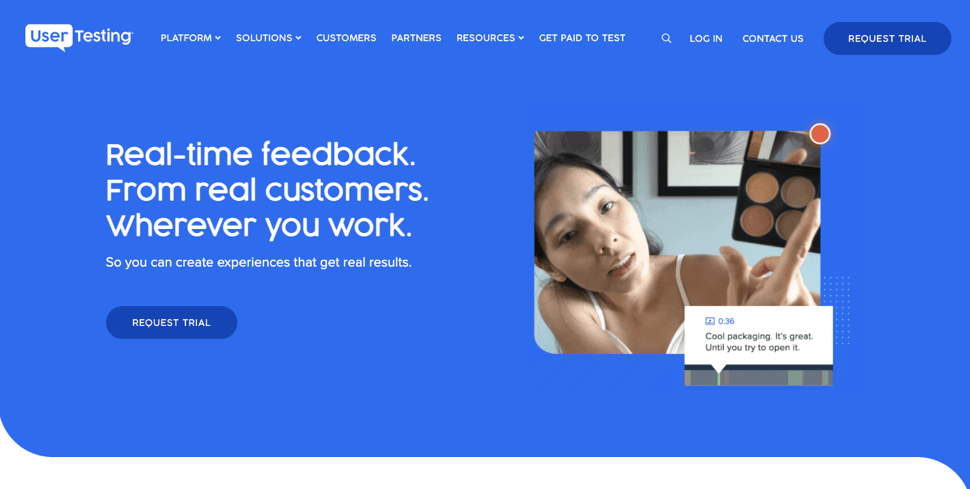
UserTesting lets you collect first-hand information about what users think about your products. The first time I saw UserTesting in action was during a pitch meeting where the product lead played a video of a user struggling through their onboarding flow. This UX testing tool follows a video-first approach so you can see and hear how participants engage with your processes, concepts, products, apps, and designs. Use the UserTesting contributor network to find the right audience for your studies.
Best For: Larger product and UX teams who want in-depth, moderated or unmoderated video feedback—especially when stakeholder buy-in is key.
Features:
- Run UX tests on your website, mobile app, and product to map user experience.
- Add your own participants or choose the suitable testers from UserTesting’s Panel.
- Create multiple usability tests like five-second, navigation, tree, first impression, pilot test, benchmark, discovery test, and card sorting.
- Add tasks, actions, and questions for the participants to follow while taking the UX test.
- Offers ready-to-use usability test templates.
- Supports screen and video recording to let users leave feedback during the test.
- Add screener questions and advanced demographic filters to disqualify ineligible participants.
- Cut, annotate, edit, or combine video feedback clips to create highlight reels to analyze the data.
- Integrate with Salesforce, Segment, Figma, and Google Analytics for centralized testing workflows and stakeholder reporting
What You Will Like:
- AI highlights key emotional moments in video sessions and summarizes user insights by theme and frequency.
- Especially useful for showcasing user feedback to execs and non-UX teams.
- Combines qualitative depth with usability task structure.
Pricing: Contact for a quote
Average User Ratings (G2): 4.5
Customer Review (G2): “It’s so easy to draft up and launch tests, and insights come in so quickly! Recently I’ve needed to test cross-devices (pushing a user desktop to app, for example) which isn’t supported yet in User Experience Research Associate
Qualitative Feedback & Video Insights
If you’re looking to capture in-depth, emotional user reactions, these tools give you face, voice, and context in rich video formats. Here are some of the top examples:
9. Userlytics
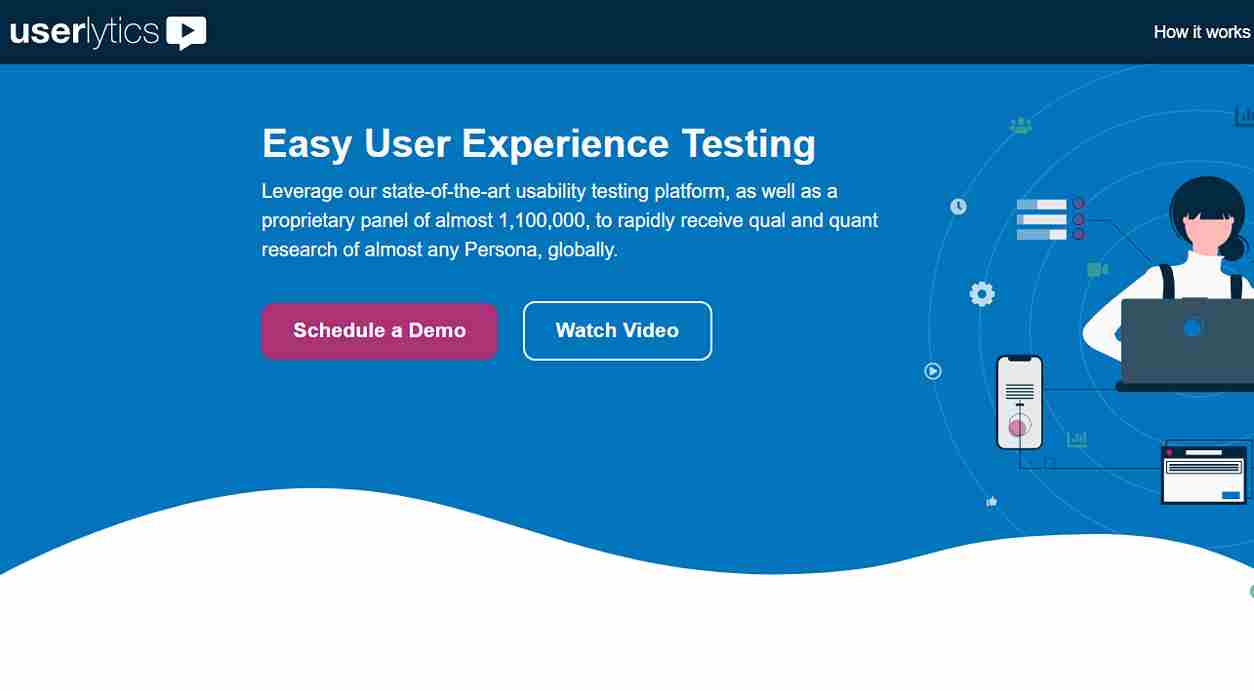
You might stumble upon Userlytics when researching how to conduct remote usability testing without building your own panel. We turned to Userlytics when we needed remote mobile UX testing without overcomplicating the setup. Teams often mention it in UX communities when they want a video-first, unmoderated testing tool with high targeting precision and without complex onboarding.
Best For: Remote usability studies that require screen recordings, participant reactions, and fast feedback, especially for mobile apps and websites.
Features:
- Multiple test types: card sorting, tree testing, usability tasks, and prototype tests.
- Picture-in-picture (PIP) video capture lets you see facial expressions and screen activity together.
- Global participant panel with 100K+ testers, searchable by demographics and behaviors.
- Branching logic, customizable branding, and multi-language support.
- Built-in analytics for task success, NPS, bounce points, and user flows.
- Integrates with Slack, Zoom, and MS Teams to manage sessions, updates, and team collaboration.
- Includes AI transcription and auto-tagging in video feedback, saving hours during analysis.
What You Will Like:
- Perfect for B2C teams looking for a mix of speed and research depth.
- The PIP recordings give rich behavioral data with emotional cues.
- You can follow up with the same users via live interviews after the test.
Pricing: Starts at $34/month. Separate credits are required for participant panel usage.
User Rating(G2): 4.4
Customer Review (G2): “Userlytics has been an amazing tool for our UX research. It’s easy to use, helps me set up tests quickly, and provides valuable feedback. Surveys are a great feature for quick feedback, but larger sample sizes can take a bit more time.” – Manuel R., UX Researcher
10. Lookback
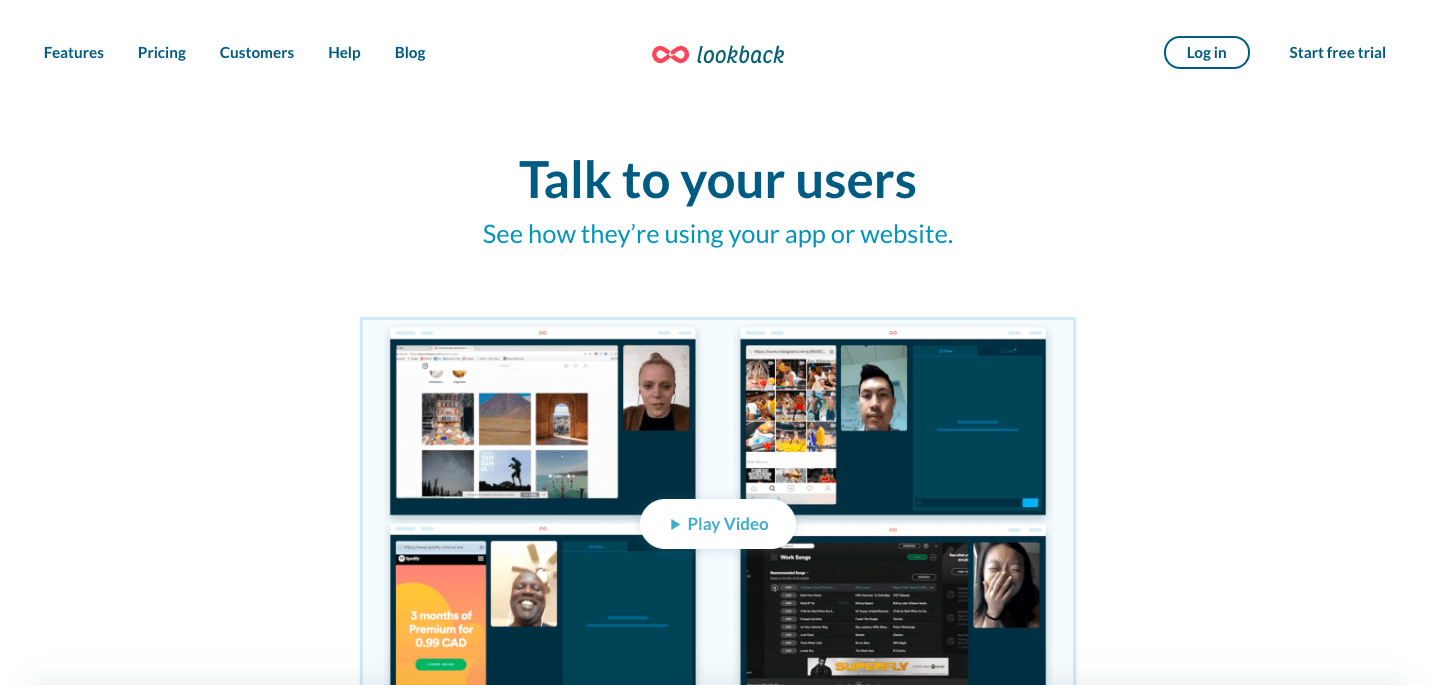
Lookback is customer research and user testing software to run usability tests and live interviews. I first came across Lookback while working with a design team that was tired of jumping between Zoom, screen recorders, and note-taking tools just to conduct a single usability session. It enables mixed methods research to turn customer experience data into insights. You can test prototypes, websites, live apps, and betas to understand what’s working for your users.
Best For: Live or asynchronous usability testing where seeing, hearing, and reacting in real time is essential, especially for early-stage feedback or exploratory research.
Features:
- Supports moderated and unmoderated user testing.
- Test on any platform, i.e., desktop, mobile app, and tablet.
- Invite participants via a public or private link that can be accessed on any device.
- Organize live interviews with your participants.
- Access the global participant panel to recruit the best testers for your studies.
- Add timestamps, transcribe sessions, add notes, and create highlight reels.
- Invite teammates, add tags, and collaborate with your team using virtual observation rooms, notes, and chat.
- AI-powered transcription and search make it easy to jump to key feedback moments across dozens of sessions.
What You Will Like:
- It replicates the energy of an in-person interview, without the scheduling nightmare.
- Timestamped note-taking during sessions means you don’t miss anything important.
- You can loop in stakeholders as silent observers for instant alignment.
Pricing: Starts at $25/month
Average User Ratings (G2): 4.3
Customer Review (G2): “When lookback works, it’s absolutely perfect! When a user is even *slightly* tech illiterate, or there are bandwidth issues, lookback suffers from the same problems as every other similar service.” – Jason B. (Verified Reviewer)
11. Dscout
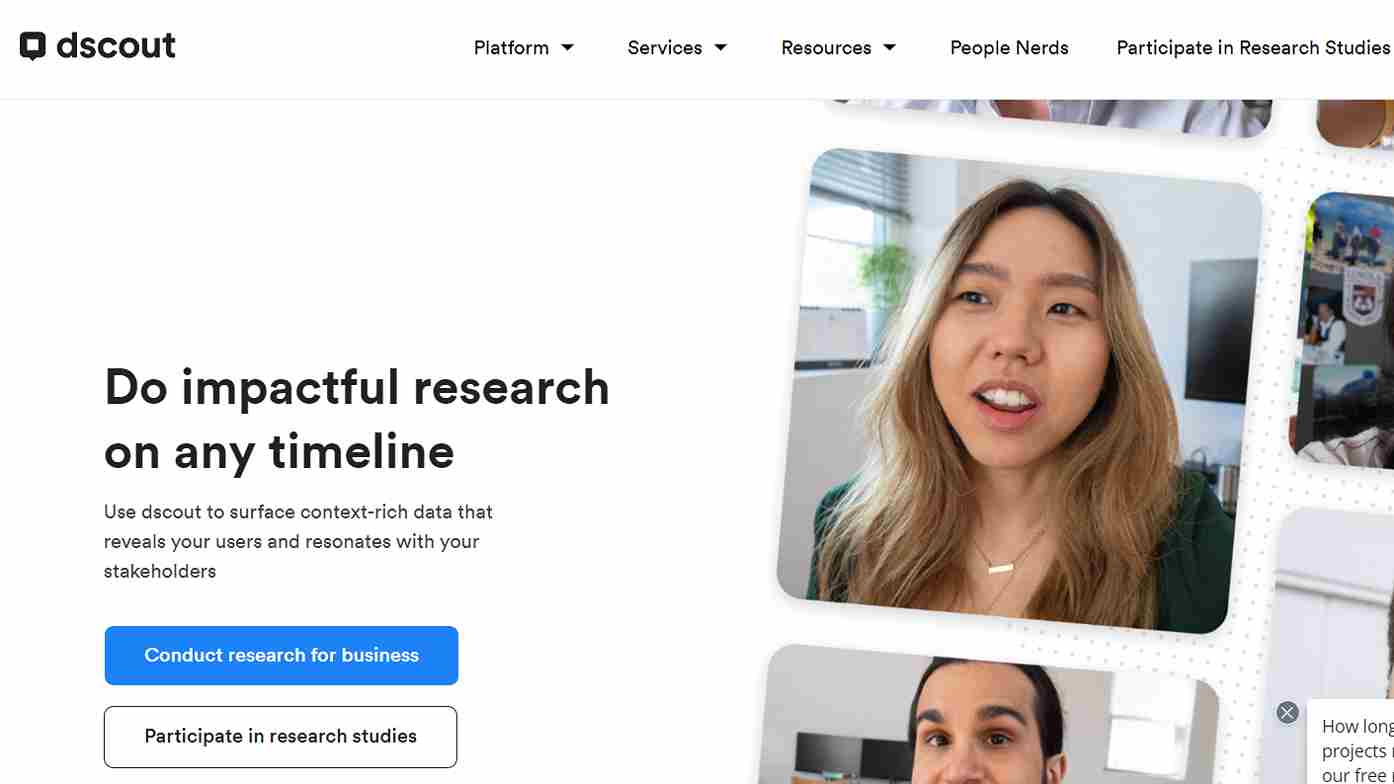
Dscout is among the leading qualitative UX research tools to conduct remote testing and collect context-rich data about your products. I first got introduced to Dscout through a UX researcher who ran diary studies with early users of a health tech app. You can efficiently perform multiple operations like prototype feedback, in-the-wild product discovery, competitive analysis, and fieldwork supplementations.
Best For: Longitudinal or in-depth qualitative UX research—especially when you want contextual, in-the-wild feedback over time (not just one-off tasks).
Features:
- Run the unmoderated remote studies on desktop and mobile devices.
- Recruit test participants from over 100K panel testers to find the right people for your UX tests.
- Supports multimedia screener surveys.
- Offer screen capture, video recording, and surveys to capture user feedback.
- Conduct live interviews with your participants to build in-depth UX research reports.
- Provides multiple observing options like auto-transcribe, live-notate, invite observers, embed stim, share screens, and more.
- Add stakeholders to your projects and assign each of them a participant to monitor the test remotely.
- Use inbuilt UX analytics tools to filter the data, add tags, cut specific video clips, add timestamps, and create highlight reels.
What You Will Like:
- NLP and AI models assist in summarizing diary study entries and grouping feedback themes across large sample sizes.
- Lets you gather rich, day-in-the-life data for real user empathy and discovery.
- Built-in video editing tools save hours in synthesis and storytelling.
Pricing: Starts at $3,000/year (custom pricing based on project scale). No public free plan available.
User Rating (G2): 4.5
Customer Review (G2): “The dscout platform is crisp and easy to use. The functionalities are good and always expanding. The complexity of question types / logic / etc. is not always available (for example, within surveys, piping is limited and there are no matrix style questions) so you sometimes need to be creative or find workarounds.” – Verified User in Banking
Participant Recruitment & Panel Management
These tools help you find, qualify, schedule, and reward participants, especially when you don’t have your own user base to pull from. Here are some of them:
12. User Interviews
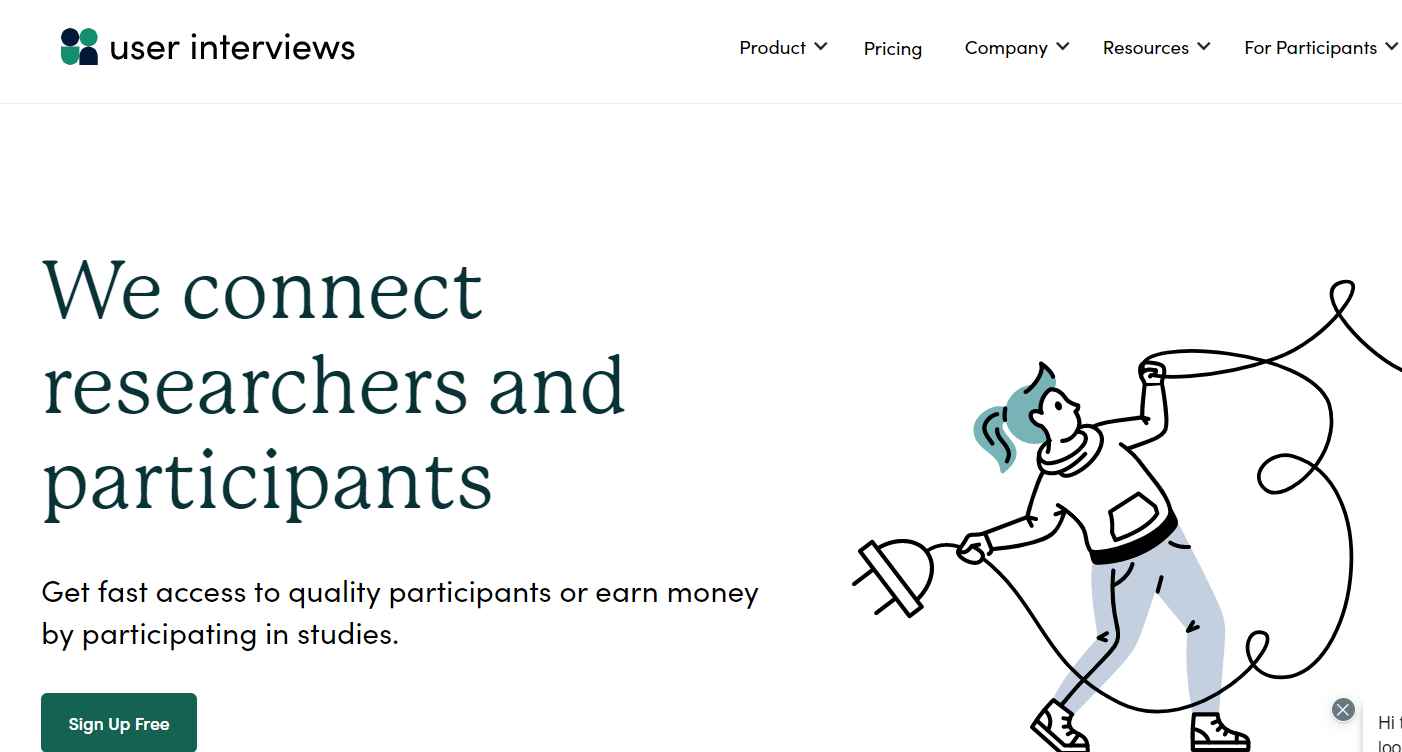
What good are the best user research tools if you can’t find the right audience for your tests? We first tapped into User Interviews when internal recruiting just wasn’t cutting it. It’s a participant recruitment tool. Most user experience testing tools have a separate participant panel, but if you are looking for a bigger sample size and better accuracy, this is the software for you. You can recruit and manage quality test participants in hours to ensure rapid testing and data reliability.
Best For: Sourcing high-quality, targeted participants for interviews, surveys, or usability tests—especially when you don’t have your own panel or need niche segments.
Features:
- Source authentic and quality UX testers from over 850K participants.
- Use built-in attributes to filter the audience based on demographics, location, profession, and other attributes.
- Build your own participant panel for remote user research projects and manage it within the tool.
- Use the Research Hub to track survey answers, history, messages, and incentives of each participant in the panel.
- Set a test schedule in the tool and sync the calendar so the participants can automatically schedule themselves for the test.
- Send bulk reminder emails and texts to participants about the upcoming UX test.
- Integrate with Zoom, Google Calendar, and Slack to streamline scheduling, communication, and team collaboration.
What You Will Like:
- AI screener scoring helps prioritize ideal candidates based on fit and availability.
- You can use the same testers again for longitudinal or iterative studies.
- Even complex studies with quotas and screener logic are surprisingly easy to manage.
Pricing: Starts at $36 per session. Bring-your-own participant options and volume discounts are available.
Average User Ratings (G2): 4.6
Customer Review (G2): “As a UX researcher, I appreciate how smooth and efficient User Interviews makes recruitment. I do wish there were more integrated tools so everything could be managed in one place, from planning to insights.” – Olga S., UX Lead
13. Ethnio.io
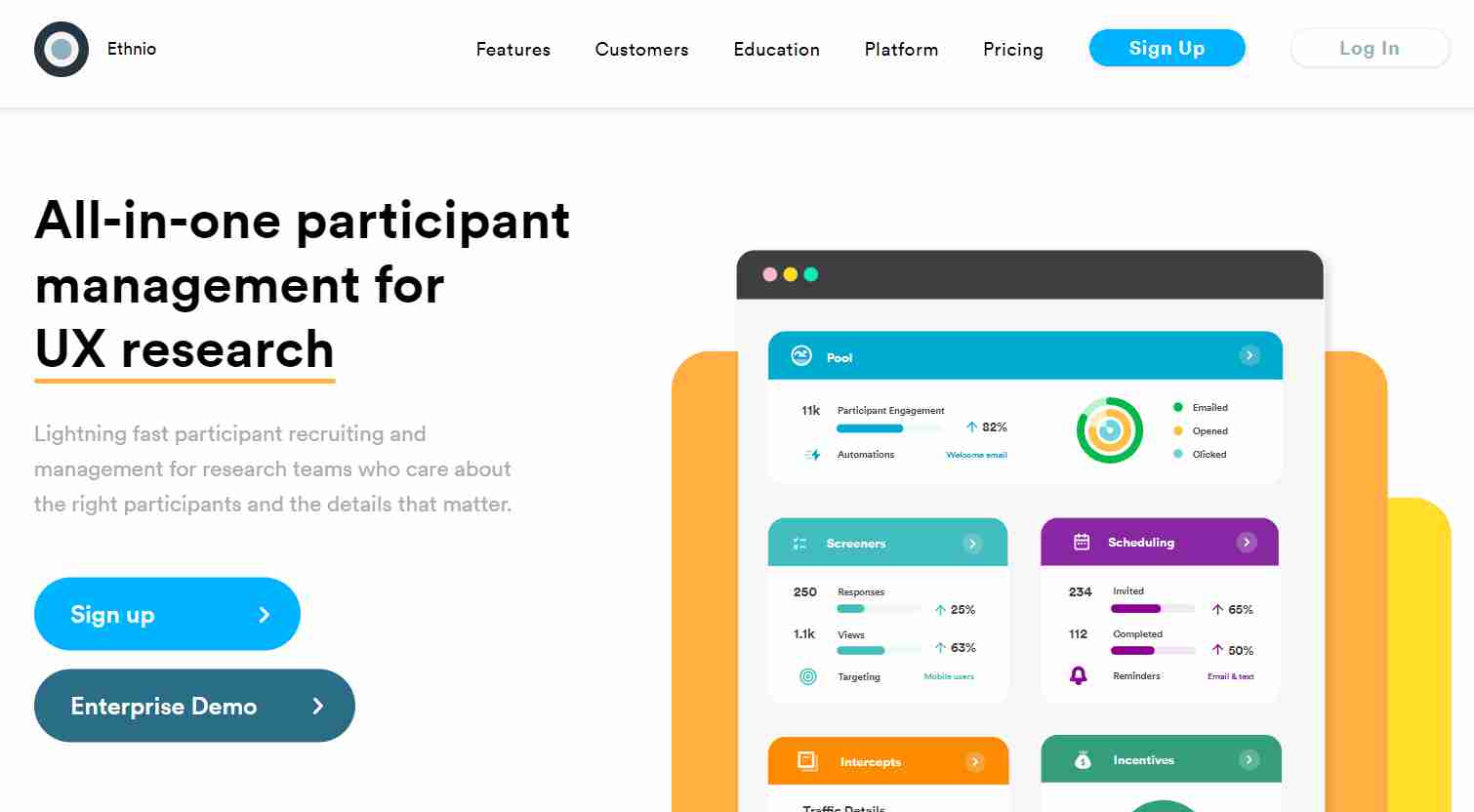
Speaking of user-research platforms for participant recruitment, Ethnio is one of the best in the market. I found Ethnio while looking for a better way to manage participant recruitment without spreadsheets and DMs scattered across Slack. It acted as a centralized database for the participant list. You can hire testers from their panel or upload your own list. This UX research CRM lets you find the right participants for your studies and manage the list in one place.
Best For: UX teams who want end-to-end control over participant management—from recruitment and screening to scheduling and incentives.
Features:
- Recruit test participants worldwide based on demographic, psychographic, and technology attributes.
- Design screener surveys using 16+ question types, skip-logic, and page logic.
- Share the screeners via email, social media, Craigslist, and more.
- You can also embed them into your website, app, and product.
- Pay participants with one click using 18+ payment options.
- Use the centralized dashboard to manage the participant pool.
- Create segments, add tags, track participant history, and set up advanced filters to manage the pool.
- Sync your calendar to schedule 1:1, group, and multi sessions.
- Add teammates, collaborators, and stakeholders to your participant list.
- Design and send personalized email reminders to selected participants.
What You Will Like:
- The screener logic and CRM-style participant dashboard are built for scale.
- Payments and reminders are automated, which saves hours post-session.
- AI-optimized scheduling helps find optimal interview windows across team and participant calendars.
Pricing: Starts at $12/month, billed annually.
Average User Ratings (G2): 4.2
Customer Review (G2): “Ethnio is created specifically for UX Research, and it shows. Every research project is different and needs specific participants, screeners, etc., and Ethnio really understands that and has tons of tools that help you really customize and templatize projects. There’s a bit of a learning curve at first, with a lot of new settings to keep track of.” – Verified User in Financial Services
Behavioral Analytics & Research Synthesis
When you want to back your qualitative insights with behavioral trends, these tools help connect the dots across the user journey. Here are a few of them:
14. Optimal Workshop

I first saw Optimal Workshop in a UX Slack group, where someone asked how to quickly test a website’s information architecture without pulling in engineers or analytics. It lets you quickly test anything from website architecture to design prototypes to build the best products. It consists of a suite of top user research tools to test, capture, and analyze user feedback and experience data in one place. You can conduct usability tests, design online surveys, and even recruit test participants from their professional panel.
Best For: UX and content teams working on IA optimization, taxonomy testing, or navigation design—especially pre-launch or during redesigns.
Features:
- Conduct multiple usability tests and UX tests on your products to optimize them.
- Leverage the dedicated panel to recruit the right participants from over 50 million users worldwide.
- Design targeted surveys to capture experience feedback from product users.
- Add surveys to your design prototypes and products to gather valuable insights.
- Use the inbuilt Reframer dashboard to analyze user interviews and usability testing data.
- Invite team members to collaborate, manage access permissions. And add hashtags to each task.
- Integrate with Figma, Google Analytics, and Jira for easier collaboration and workflow visibility.
What You Will Like:
- Uses AI to surface common IA patterns and click behavior trends in tree tests and card sorting.
- Great for testing early wireframes, content structure, or sitemap logic.
- Reframer adds qualitative depth, so you’re not just guessing at click data.
Pricing: Starts at $107/user/month, billed annually.
Average User Ratings (Capterra): 4.4
Customer Review (Capterra): “Great for performing UX research. But once questions have been written for a survey, you can’t drag and drop them in a different order, you have to delete and start again.- While recruitment is quick to come back I find many responses are completed too quickly and I have to spend considerable time looking through responses to check which are genuine.” – Rebecca, Senior UX Researcher
15. Mixpanel
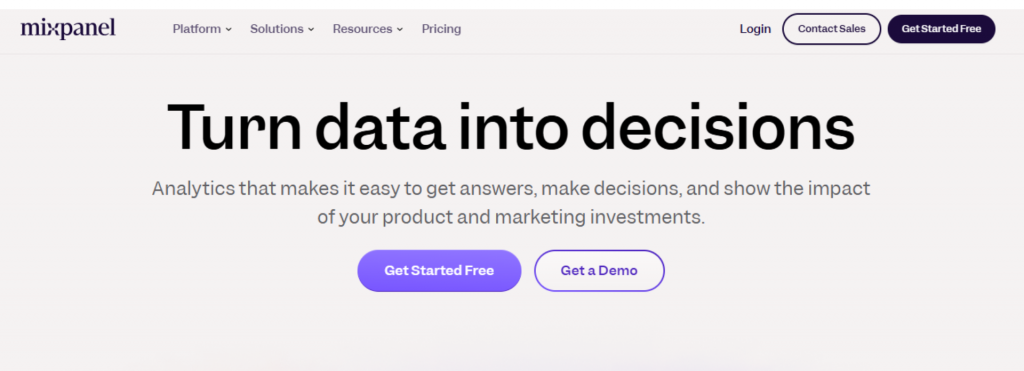 Mixpanel is a UX analytics tool that gives you detailed data about product engagement and user insights. I came across it when we were frustrated that GA4 doesn’t explain why users drop off. Mixpanel bridges that gap. You can see how users interact with your product, the most popular features, who your best customers are, and where users drop off across the funnel. The tool integrates rich dashboards to help you slice and dice the data to study user behavior trends, track user segments, and understand their journey in numbers.
Mixpanel is a UX analytics tool that gives you detailed data about product engagement and user insights. I came across it when we were frustrated that GA4 doesn’t explain why users drop off. Mixpanel bridges that gap. You can see how users interact with your product, the most popular features, who your best customers are, and where users drop off across the funnel. The tool integrates rich dashboards to help you slice and dice the data to study user behavior trends, track user segments, and understand their journey in numbers.
Best For: Teams that want to quantify user experience by analyzing real behavior—think drop-offs, feature adoption, or which user segments retain best.
Features:
- Build funnels on the go and analyze friction points at each stage.
- Segment the user journey by attribute or behavior metrics to understand which users convert best.
- Identify important user paths that offer frictionless conversions.
- Use the launch impact feature to see how new features affect conversions and user behavior.
- Run A/B tests to find the winning variants of your product design with high statistical significance.
- Offers detailed dashboards to monitor key performance metrics of your products.
- Track any spike or drop in trends to spot and fix critical issues on time.
- Integrate with Amplitude, Segment, HubSpot, and Google BigQuery to unify behavioral and product data streams.
What You Will Like:
- Predictive analytics and anomaly detection powered by machine learning surface critical trends automatically.
- Funnels and dashboards are incredibly intuitive, even for non-analysts.
- Complements qualitative feedback by grounding it in hard data.
Pricing: Paid plans start at $25/month
Average User Ratings (G2): 4.6
Customer Review (G2): “It is easy to use, even if you don’t have developer’s background. If the people using it don’t document the events properly, it is hard to discover what it is for and can become messy.” – Larissa M., Product Designer
16. Evolt.io
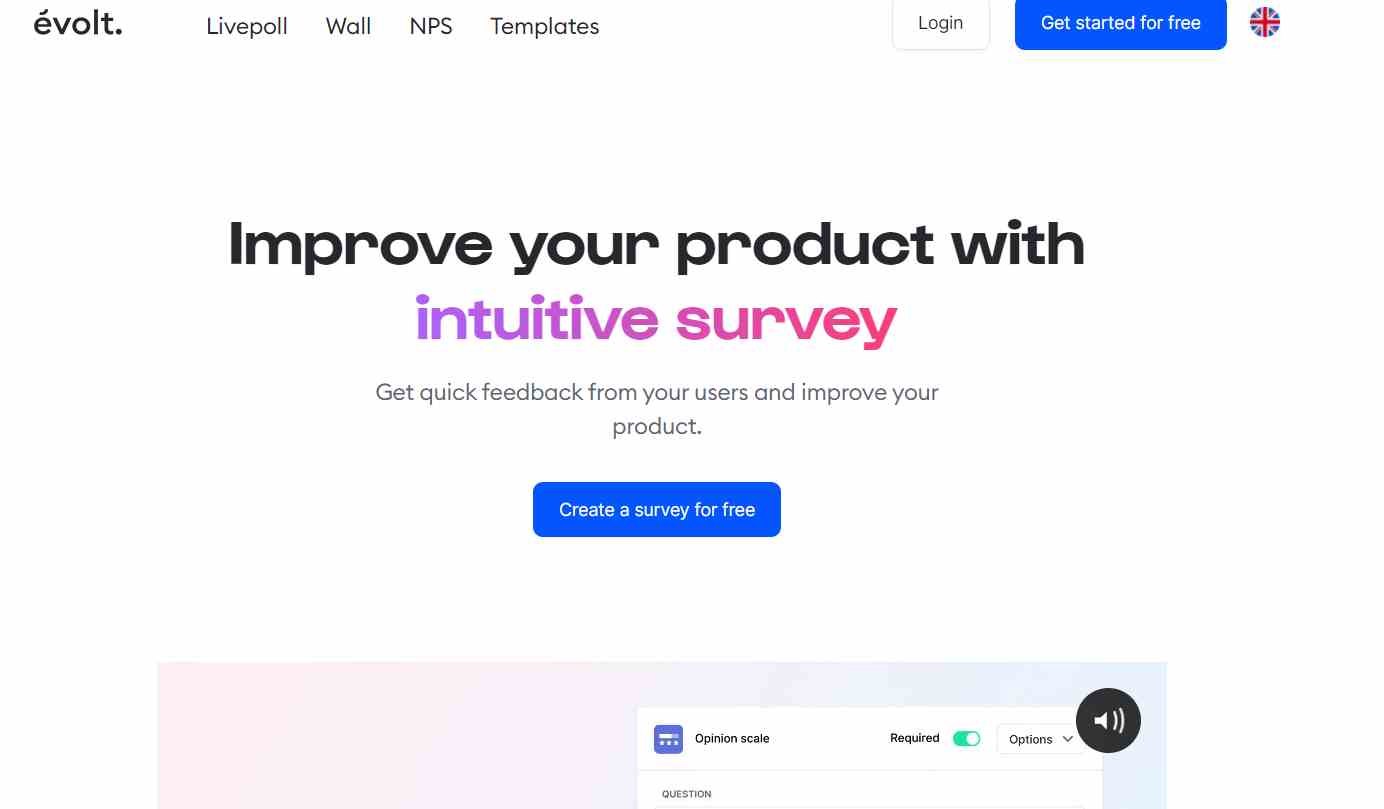 I stumbled across Evolt.io while researching tools that could help connect post-survey insights to actual product design. What caught my attention? It wasn’t just another survey tool. Evolt.io is among the best survey-based user research tools to collect feedback about your product designs. Its design suite offers multiple tools like the suggestion board, survey tool, persona builder, journey mapping, and more. Plus, you can collaborate with other team members to brainstorm ideas and work on the feedback data. Best For: Early-stage product teams or solo UX leads who need to turn feedback into personas, journey maps, and design direction without using five different tools. Features:
I stumbled across Evolt.io while researching tools that could help connect post-survey insights to actual product design. What caught my attention? It wasn’t just another survey tool. Evolt.io is among the best survey-based user research tools to collect feedback about your product designs. Its design suite offers multiple tools like the suggestion board, survey tool, persona builder, journey mapping, and more. Plus, you can collaborate with other team members to brainstorm ideas and work on the feedback data. Best For: Early-stage product teams or solo UX leads who need to turn feedback into personas, journey maps, and design direction without using five different tools. Features:
-
Create surveys, questionnaires, and live polls to collect UX feedback on your product templates.
-
Offers multiple question types, real-time preview, skip-logic, survey testing tool, and other features to design targeted surveys.
-
Choose from over 20 ready-to-use survey templates to conduct user research.
-
Add a suggestion board to the website or product to collect ideas, suggestions, and feedback.
-
Provides pre-built templates to create buyer personas and journey maps using the feedback data to gauge user experience.
- Integrate with Slack and leverage manual workflows with Figma for design handoff and collaboration.
- Leverage NLP to summarize open-ended responses and suggest user sentiment tags for personas and journey mapping.
What You Will Like:
- Combines insight capture and synthesis into one lightweight workflow.
- Helpful when you’re building personas or empathy maps from fresh research.
- Great for startups or UXers who want more strategic output from their research stack.
Pricing: Contact for a quote
Average User Ratings (G2/Capterra): Not available
Buyer’s Checklist: What to Look For In Your UX Research Tool
Use this checklist to confidently choose the right user research tools and methods based on your goals, team size, and research depth:
| Evaluation Area | Questions to Ask |
|---|---|
| 1. Define the Job | - Do you need feedback on prototypes or live products? - Are you testing usability or gathering sentiment? - Do you need moderated, unmoderated, or both? - Is this for one-time research or ongoing discovery? |
| 2. Research Methods & Features | - Does it support surveys with logic and targeting? - Can it run usability tests like click tests, tree testing, A/B tests? - Are heatmaps or screen recordings included? - Is it suitable for diary studies or journey mapping? - Can you analyze IA or conduct card sorting? |
| 3. Participant Management | - Does it offer a built-in panel with targeting? - Can you bring your own users? - Are scheduling, reminders, and incentive workflows included? - Is it GDPR-compliant? |
| 4. Integrations & Workflow Fit | - Does it integrate with Figma/Adobe XD for prototypes? - Does it sync with Slack or Teams for collaboration? - Can you connect CRM/email tools like Salesforce or HubSpot? - Is it compatible with analytics tools like GA, Mixpanel, or Segment? - Does it support Zoom or Google Calendar for interviews? |
| 5. Reporting & Collaboration | - Are dashboards and reports shareable? - Can you tag, annotate, and build highlight reels? - Does it support team collaboration or exports for stakeholders? |
| 6. Pricing & Scalability | - Does the pricing model align with your usage? - Is there a free plan or trial? - Will it scale with your team and needs? - Is support reliable and available? |
Benefits of Using a UX Research Software
Regardless of the type of UX research tool you use at your end, it can provide a lot of positive results in your business, such as:
Gauge users’ experience in a natural environment
UX research tools easily integrate with your product or design prototype, allowing you to observe users in actual working conditions. You can record users interacting with the product to understand where they face problems and what elements they like. This provides more in-depth data than controlled testing.
Pinpointing exact product issues
Expanding on the previous point, most UX testing tools let you design dedicated tasks for participants to perform during the test. These can be following a series of outlined steps, reaching a particular page, navigating the menu, or sorting out the categories and subcategories.
In the case of survey-based tools, you create a survey and target specific customer behavior and actions.
Both tool types let you pinpoint where customers face issues with the products. It can be minor errors, significant bugs, or simply a complex UI. You can also collect data on how easy it was for the user to complete the task or action to optimize it further.
Gather early feedback
How early are we talking about? Well, as early as the conception of a product idea.
With the best UX research tools, you can validate the product concept with tests like card sorting and paper prototyping long before committing to development.
It helps weed out problematic areas before they creep into the product. You can do this at every stage of product development.
The net effect is lower development costs, better product build, and rapid testing.
Improve product adoption
Since the product is optimized at various development stages, you release a nearly optimal product solution. Throw in a good onboarding process, and you have the perfect recipe for improving product adoption and retention. You can run further optimization with survey-based UX research tools to gather feedback about users’ experience with the released product.
Did You Find Your UX Research Tool in the List?
There it is! The complete list of top UX research tools with the benefits and drawbacks, all in one place.
User experience is the key to success. In fact, people are willing to pay more for a seamless experience. So, investing in good UX research tools makes sense.
Our advice: Use a mix of UX research tools to get a complete view of the user experience(UX) index.
Start with a usability testing tool like UserTesting to optimize your prototypes and mockup designs. Once you have the results of your tests, bring in the tools like Qualaroo that can help you collect contextual insights via surveys and questionnaires.
It can add more depth to the data sets collected. These survey-based user research tools can help you gauge user experience at every stage of product development and beyond.
So bring out your requirement list and start cross-referencing the features as you go through our list to find the perfect tool for your business and build an effortless user experience.
Frequently Asked Questions
What are the three pillars of UX?
The three pillars of an effective UX are content, design, and code.
What is UX research software?
UX research software helps teams understand how users experience your product—what’s working, where they get stuck, and why they leave. These tools enable everything from in-product surveys and usability tests to behavioral analytics and journey mapping. Tools like Qualaroo stand out by capturing feedback at the exact moment a user experiences friction, right inside your product, not after the fact.
What are UX research methodologies?
UX research methodologies refer to the techniques used to gather user insights. These include:
- Quantitative: Surveys, heatmaps, session recordings, A/B tests.
- Qualitative: Live interviews, diary studies, usability sessions.
- Behavioral: Funnel analysis, clickstreams, time-on-task studies.
Attitudinal: Net Promoter Score (NPS), CSAT, open-ended surveys.
A hybrid approach works best. For example, use Qualaroo to gather real-time attitudinal insights directly within your product, then pair it with a tool like Maze or UserTesting for behavioral validation.
What are the six tools of UX research?
Here’s a practical stack used by modern teams:
- Qualaroo – for contextual, AI-analyzed in-product feedback.
- Maze – for quick prototype validation and flow testing.
- UXtweak – for tree testing, card sorting, and usability benchmarking.
- User Interviews – to recruit high-quality participants fast.
- Mixpanel – to quantify user behavior and track engagement trends.
- Dscout – for deep, qualitative diary studies and video feedback.
How can I collect user feedback inside my product?
Use a live intercept tool like Qualaroo, which lets you place targeted Nudges™ on specific pages, flows, or actions. Unlike traditional survey tools, it doesn’t just ask questions—it listens contextually. You can trigger questions based on scroll depth, time on page, exit intent, or even user segment. It’s ideal for optimizing onboarding, pricing pages, or any high-friction part of your UX.
How early should I start UX research?
Start as early as possible—ideally when validating your product concept or MVP. Tools like Maze are great for early prototype testing, but Qualaroo gives you the added advantage of surfacing user sentiment the moment they interact with your design or product idea, especially when embedded in prototypes via Figma or Adobe XD.
What features should I look for in a UX research tool?
It depends on your team’s maturity and budget, but high-impact tools typically offer:
- In-product targeting and behavioral triggers (only a few like Qualaroo do this well)
- Survey logic, NPS/CSAT templates, and multi-language support
- AI analysis (e.g., sentiment detection, tag suggestion, word clouds)
- Integrations with Figma, GA, HubSpot, Slack, or Segment
- Participant recruitment or panel management
- Reporting that’s shareable with stakeholders
 Tips
Tips
We’d love to hear your tips & suggestions on this article!
FREE. All Features. FOREVER!
Try our Forever FREE account with all premium features!
 We'd love your feedback!
We'd love your feedback! Thanks for your feedback!
Thanks for your feedback!





